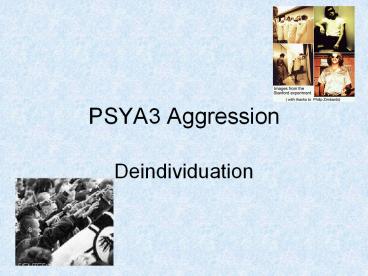PSYA3 Aggression PowerPoint PPT Presentation
1 / 17
Title: PSYA3 Aggression
1
PSYA3 Aggression
- Deindividuation
2
Lesson 2 Deindividuation
- BATs
- A01 Explain the causes of aggression according to
deindividuation - A02 Evaluate deindividuation
http//www.psychexchange.co.uk/videos/view/20511/
klu klux klan
3
Deindividuation
- Normal constraints on behaviour are weakened when
a person loses their sense of individuality - Crowds, uniforms, drugs alcohol
- Less likely to be identified held responsible
for aggressive behaviour - Anonymity?deindividuation?aggression
- More pronounced drunk/drugs
- Based on Le Bons crowd behaviour theory
www.psychlotron.org.uk
4
Deindividuation
www.psychlotron.org.uk
5
Deindividuation
www.psychlotron.org.uk
6
Deindividuation
- Zimbardo (1969)
- Hooded PPs were more aggressive
- Zimbardo (1973 Stanford Experiment)
- Guards aggression increased by uniforms,
sunglasses, night-time - Mullen (1985)
- Violence of mob lynching a function of crowd size
www.psychlotron.org.uk
7
The process
- Being anonymous your inner constraints are
reduced and your fear of consequences are
reduced. - Lose sense of personal values and social norms.
www.psychlotron.org.uk
8
AO2 Research Support
- Zimbardo (1969) - 2 Conditions
- 1.) Deindividuated
- 2.) Control
- RESULTS?
- Lab coats, hoods
- No introductions
- Group instructions
- Normal clothes and name tags
- Introductions by name
- Individual instructions
9
Furthermore...
- Johnson and Shacks showed that...
So what can we conclude from this..???
People respond to normative cues associated with
the social context they are in
10
Real world applications
- Mann (1981)
- Baiting crowd and suicide jumpers
- Other ideas??
11
Prosocial consequences of deindividuation
- Spivey and Prentice-Dunn (1990)
- Deindividuation could lead to either pro or
antisocial behaviour depending on situational
factors - Prosocial cues led to more altruistic acts and
fewer antisocial acts
12
More AO2
- Cultural differences
- Gender differences
- Diener 1973
- Watson (1973)
13
Environmental Stressors
- Stress ? Arousal ? Aggression
- As arousal increases it becomes easier to trigger
an aggressive response (up to a point)
www.psychlotron.org.uk
14
Environmental Stressors
Likelihood of aggressive behaviour
www.psychlotron.org.uk
Level of stress
15
Lack of Support for Deindividuation
- Postmes and Spears 1998 meta analysis of 60
studies - Insufficient support for major claims of
deindividuation such as disinhibition and reduced
self awareness
16
Over to you
- Answer the questions
- Plan and write an essay either qu 4 p61 or qu4
p63
17
Holiday Homework
- Start Revising!! use the Outcome sheets to see
how much you can remember about Sleep and
Relationships - Make a list of topics you find hard and let me
have that when we return so I can tailor the
revision sessions to these areas. - Also revise Retake units find your old notes
- I will try and put some past papers on the blog
Catch up on any work missed please

